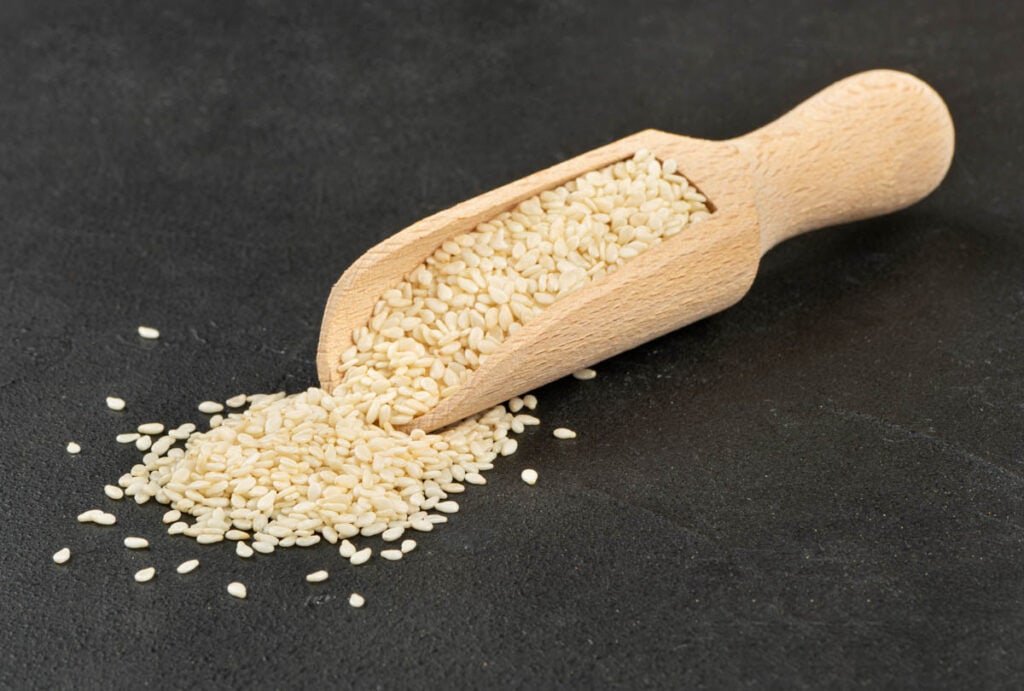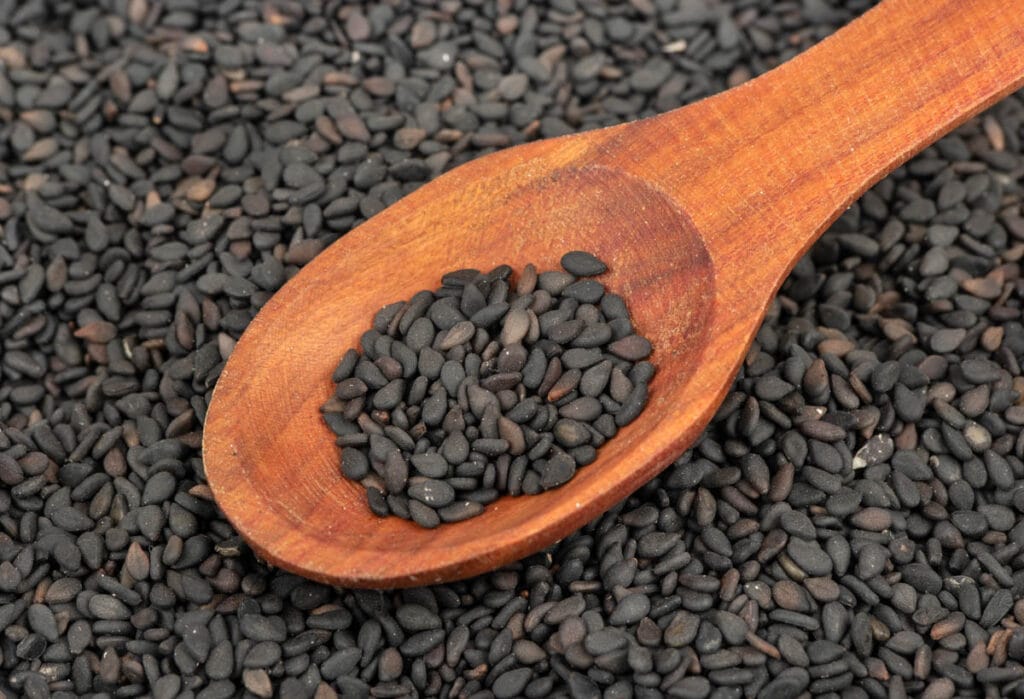Sesame seeds grow in pods on the sesame plant. They are used in spice blends, baked goods, sauces, marinades and as a garnish. You can toast them, crush them or leave them whole. With a mild, savory and lightly sweet taste, sesame seeds are a characteristic flavor to a wide variety of dishes.

Selecting sesame seeds
Sesame is a hardy, drought-tolerant plant that grows best in well-draining soil and full sunlight. It can withstand high temperatures and low moisture conditions.
The flowers of the sesame plant grow into seed pods, which turn brown when they are ready to be harvested. You can hull the seeds in two ways. In a dry hulling method, you will dry them before dehulling. In a wet hulling method, you will soak the seeds in water overnight to soften the hull.
If you don’t have space for an outdoor garden to grow your sesame plants, you can buy them at spice shops or from your local market. The seeds you buy at a grocery store will be hulled.
When buying seeds, purchase a product that has an airtight container. There are two types of seeds you can buy: white and black. Hulled white sesame seeds should be a pure white color. Black sesame seeds should be a dark black color.

Avoid packages with discolored seeds. Packages should be absent of excess moisture as well.
The taste of sesame seeds
Sesame seeds have a distinct taste that is a combination of nuttiness and earthiness. They are primarily savory with a sweet, rich undertone and, when toasted, develop a more intense flavor profile. They have a soft crunch as well.
“I love the versatility of sesame seeds. They come in black or white varieties and can either be used in sweet or savory applications. Grind them into a powder to add to cereal, baked goods, or turn it into a paste for filling buns. You can also leave the seeds whole, lightly toast them and sprinkle them on anything from buns, bread, rice or meat and vegetables to give them a little texture and nutty crunch.”
— Michelle C, Sift and Simmer
Benefits of sesame seeds
Dietitians also report sesame seeds can be beneficial to your health in a number of ways. They add nutrients, including vitamins and fiber, to your meal.
“In addition to having a delicious subtle nutty flavor, sesame seeds are a good source of healthy fats, protein, B vitamins, minerals, fiber and antioxidants. I love sprinkling sesame seeds on top of my stir fry, salads, yogurt bowls and even oatmeal.”
— Anne Mauney, RD, fANNEtastic food
Cleaning sesame seeds
Unlike fresh herbs like parsley or basil, you do not need to wash sesame seeds under running water. You can simply remove any debris or dirt from your seeds. Whether you harvested them from your own garden or purchased them from the store, they are ready to store once this step has been completed.

Storage suggestions
If you have harvested your own seeds, store them in an airtight container in a cool, dry place like a pantry. They will last for about six months.
If you have purchased your seeds, store them in the container they came in. Much like mustard seeds, sesame seeds should be stored in a cool, dry place. Proper storage will preserve the texture and flavor of the seeds for a longer time.
Sesame seeds can also be frozen. Store them in their original packaging, or label an airtight, freezer-safe container with the date. They will remain usable for a year.
Culinary uses for sesame seeds
Mellow spices like sesame seeds should be used as a flavoring or topping for most dishes. Toasting them will release their nutty flavor. Ground sesame seeds can be added to a variety of baked goods and condiments.
“Sesame seeds offer a mildly sweet and nutty taste to all kinds of dishes. Toasting them helps to intensify their flavor, giving them a smokier flavor than raw seeds. Buy them in bulk, toast them and grind them up to make your own tahini.”
— Susannah Brinkley Henry, Feast + West
Add sesame seeds to spice blends, like everything bagel seasoning, and use the blend on everything from roast chicken to avocado toast. You can also incorporate them into baked goods like bagels, muffins, cakes and cookies. They are excellent as a garnish on salads, cold noodle dishes or stir-fries.
Try them as the coating for different proteins, like seared tuna. You can also add them to marinades, dressings and sauces.

Sesame seeds are used in many cuisines. Middle Eastern, Asian, North African, European and North American recipes all utilize these ingredients.
Final thoughts
Sesame plants are drought-resistant flowering plants that produce sesame seed pods. The seeds have a mild flavor with notes of earthiness, nuttiness and sweetness.
You can buy them year-round at spice shops, grocery stores and local markets. If you are purchasing white sesame seeds, choose ones that are bright white. Black sesame seeds should be uniformly dark in color. Ensure the containers are airtight and don’t contain moisture.
Store either homegrown or storebought seeds in an airtight container in a cool, dry place. You can also freeze the seeds for up to a year.
Use them in condiments like spice blends or tahini, sprinkle over roasted or seared meats and seafood, include them in marinades, sauces and dressings or as a garnish on baked goods. Toasting will enhance their flavor.
Whether you are planning for a dinner party or trying out a new baked good, sesame seeds can add a savory, nutty taste to dishes from a range of cuisines across the globe. Be sure to add them to your grocery list and discover all of the delicious possibilities.
Gen La Rocca is a professional chef, writer and editor living in Southern California. She is the owner and recipe creator behind Two Cloves Kitchen, a food site featuring contemporary, California-inspired recipes. She has edited over 20 novels, short stories and essays for publication.